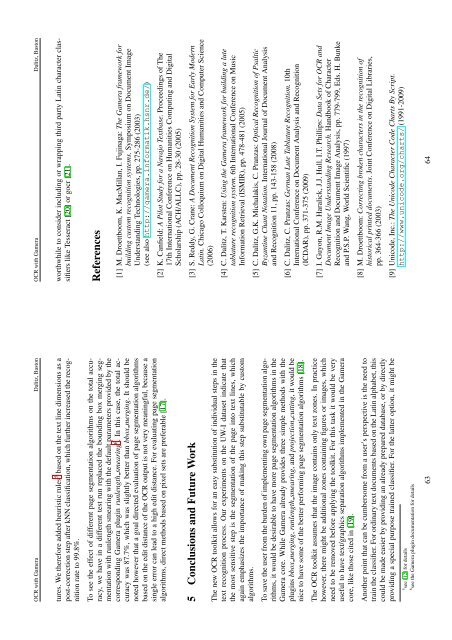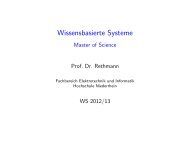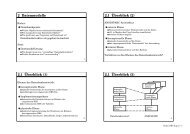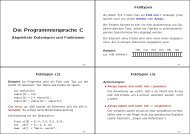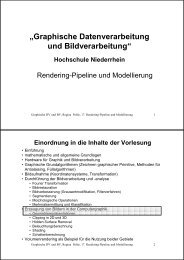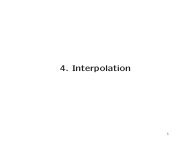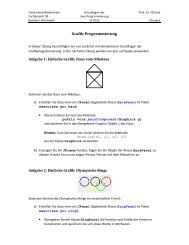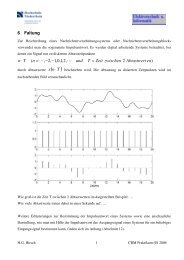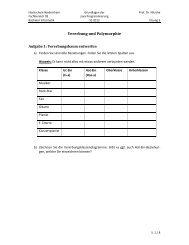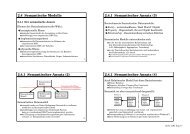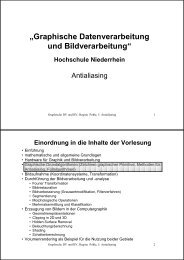O pticalCharacter Recognition w ith the G am era F ram ew ork
O pticalCharacter Recognition w ith the G am era F ram ew ork
O pticalCharacter Recognition w ith the G am era F ram ew ork
You also want an ePaper? Increase the reach of your titles
YUMPU automatically turns print PDFs into web optimized ePapers that Google loves.
OCR w<strong>ith</strong> G<strong>am</strong><strong>era</strong> Dalitz, Baston<br />
OCR w<strong>ith</strong> G<strong>am</strong><strong>era</strong> Dalitz, Baston<br />
worthwhile to consider including or wrapping third party Latin character classifiers<br />
like Tess<strong>era</strong>ct [20] or gocr [21].<br />
tures. We <strong>the</strong>refore added heuristic rules5 based on <strong>the</strong> text line dimensions as a<br />
post-correction step after kNN classification, which fur<strong>the</strong>r increased <strong>the</strong> recognition<br />
rate to 99.8%.<br />
References<br />
[1] M. Droettboom, K. MacMillan, I. Fujinaga: The G<strong>am</strong><strong>era</strong> fr<strong>am</strong><strong>ew</strong><strong>ork</strong> for<br />
building custom recognition systems. Symposium on Document Image<br />
Understanding Technologies, pp. 275-286 (2003)<br />
(see alsohttp://g<strong>am</strong><strong>era</strong>.informatik.hsnr.de/)<br />
To see <strong>the</strong> effect of different page segmentation algor<strong>ith</strong>ms on <strong>the</strong> total accuracy,<br />
we have in a different test run replaced <strong>the</strong> bounding box merging segmentation<br />
w<strong>ith</strong> runlength smearing w<strong>ith</strong> <strong>the</strong> default par<strong>am</strong>eters provided by <strong>the</strong><br />
corresponding G<strong>am</strong><strong>era</strong> plugin runlength smearing6 . In this case, <strong>the</strong> total accuracy<br />
was 87.7%, which was slightly better than bbox merging. It should be<br />
noted however that a goal directed evaluation of page segmentation algor<strong>ith</strong>ms<br />
based on <strong>the</strong> edit distance of <strong>the</strong> OCR output is not very meaningful, because a<br />
single error can lead to a high edit distance. For evaluating page segmentation<br />
algor<strong>ith</strong>ms, direct methods based on pixel sets are pref<strong>era</strong>ble [17].<br />
[2] K. Canfield: A Pilot Study for a Navajo Textbase. Proceedings of The<br />
17th International Conference on Humanities Computing and Digital<br />
Scholarship (ACH/ALLC), pp. 28-30 (2005)<br />
[3] S. Reddy, G. Crane: A Document <strong>Recognition</strong> System for Early Modern<br />
Latin. Chicago Colloquium on Digital Humanities and Computer Science<br />
(2006)<br />
5 Conclusions and Future W<strong>ork</strong><br />
[4] C. Dalitz, T. Karsten: Using <strong>the</strong> G<strong>am</strong><strong>era</strong> fr<strong>am</strong><strong>ew</strong><strong>ork</strong> for building a lute<br />
tablature recognition system. 6th International Conference on Music<br />
Information Retrieval (ISMIR), pp. 478-481 (2005)<br />
The n<strong>ew</strong> OCR toolkit allows for an easy substitution of individual steps in <strong>the</strong><br />
text recognition process. Our experiments on <strong>the</strong> UW-I dataset indicate that<br />
<strong>the</strong> most sensitive step is <strong>the</strong> segmentation of <strong>the</strong> page into text lines, which<br />
again emphasizes <strong>the</strong> importance of making this step substitutable by custom<br />
algor<strong>ith</strong>ms.<br />
[5] C. Dalitz, G.K. Michalakis, C. Pranzas: Optical <strong>Recognition</strong> of Psaltic<br />
Byzantine Chant Notation. International Journal of Document Analysis<br />
and <strong>Recognition</strong> 11, pp. 143-158 (2008)<br />
[6] C. Dalitz, C. Pranzas: German Lute Tablature <strong>Recognition</strong>. 10th<br />
International Conference on Document Analysis and <strong>Recognition</strong><br />
(ICDAR), pp. 371-375 (2009)<br />
To save <strong>the</strong> user from <strong>the</strong> burden of implementing own page segmentation algor<strong>ith</strong>ms,<br />
it would be desirable to have more page segmentation algor<strong>ith</strong>ms in <strong>the</strong><br />
G<strong>am</strong><strong>era</strong> core. While G<strong>am</strong><strong>era</strong> already provides three simple methods w<strong>ith</strong> <strong>the</strong><br />
plugins bbox merging, runlength smearing, and projection cutting, it would be<br />
nice to have some of <strong>the</strong> better performing page segmentation algor<strong>ith</strong>ms [18].<br />
[7] I. Guyon, R.M. Haralick, J.J. Hull, I.T. Phillips: Data Sets for OCR and<br />
Document Image Understanding Research. Handbook of Character<br />
<strong>Recognition</strong> and Document Image Analysis, pp. 779-799, Eds. H. Bunke<br />
and P.S.P. Wang, World Scientific (1997)<br />
The OCR toolkit assumes that <strong>the</strong> image contains only text zones. In practice<br />
however, <strong>the</strong>re might be additional zones containing figures or images, which<br />
need to be removed before applying <strong>the</strong> toolkit. For this task it would be very<br />
useful to have text/graphics separation algor<strong>ith</strong>ms implemented in <strong>the</strong> G<strong>am</strong><strong>era</strong><br />
core, like those cited in [19].<br />
[8] M. Droettboom: Correcting broken characters in <strong>the</strong> recognition of<br />
historical printed documents. Joint Conference on Digital Libraries,<br />
pp. 364-366 (2003)<br />
Ano<strong>the</strong>r point that can be cumbersome from a user’s perspective is <strong>the</strong> need to<br />
train <strong>the</strong> classifier. For ordinary text documents based on <strong>the</strong> Latin alphabet, this<br />
could be made easier by providing an already prepared database, or by directly<br />
providing a special purpose trained classifier. For <strong>the</strong> latter option, it might be<br />
[9] Unicode, Inc.: The Unicode Character Code Charts By Script.<br />
http://www.unicode.org/charts/ (1991-2009)<br />
5see [12] for details<br />
6see <strong>the</strong> G<strong>am</strong><strong>era</strong> plugin documentation for details<br />
64<br />
63


